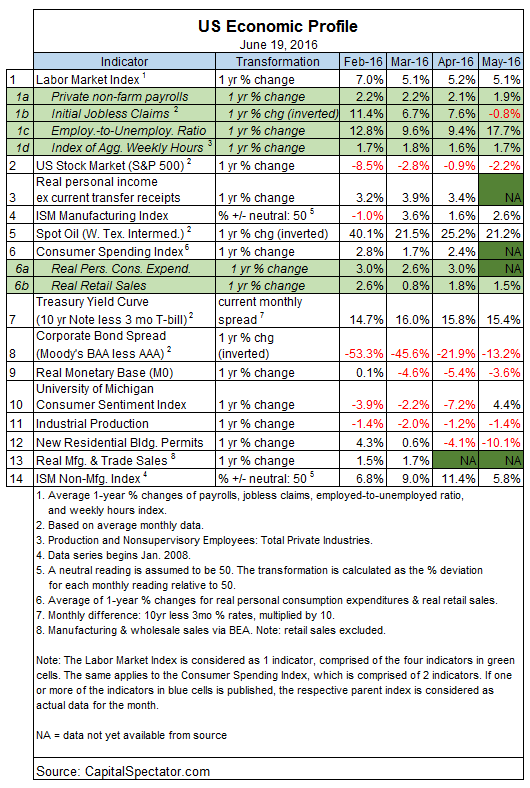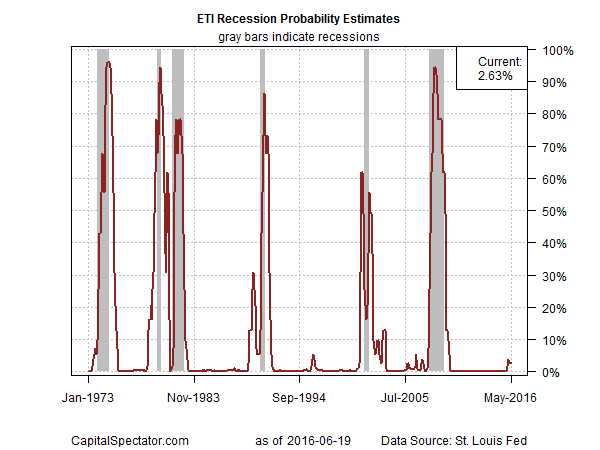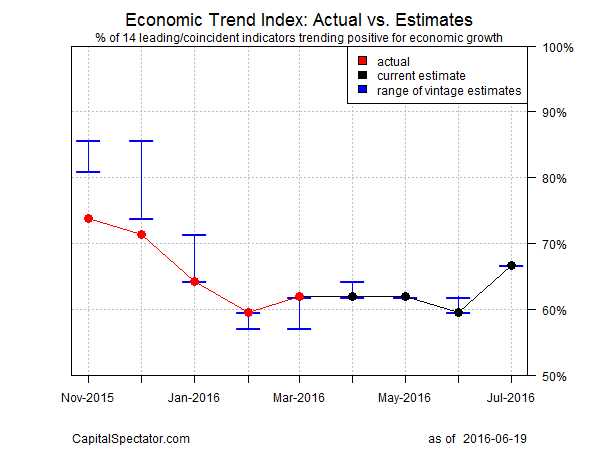The key question these days for judging the outlook for the US economy: Is the sharp slowdown in job growth in May a sign of trouble in the months ahead or just a temporary blip for an otherwise healthy if aging economic expansion? We’ll have the first instalment on an answer when the government publishes the June employment report in a few weeks.
Meantime, the incoming numbers paint a mixed profile overall for the US macro trend, although there’s still no smoking gun for arguing that a new recession started last month via a broad review of the data.
By some measures, the odds look encouraging that the Bureau of Economic Analysis (BEA) late next month will report a solid rebound in GDP growth for the second quarter. The Atlanta Fed’s current GDPNow estimate (as of June 17) is looking for a 2.8% rise in Q2 (seasonally adjusted annual rate), which represents a solid improvement over Q1’s weak 0.8% gain. The New York Fed’s 2.0% Q2 nowcast is softer, but here too the outlook still marks a decent revival in economic activity, based on the bank’s June 17 projection.
As for the numbers in hand, the broad trend continues to reflect growth that’s strong enough to keep an NBER-defined recession at bay as of May. The strength of the expansion has downshifted lately, but last month’s momentum was still firm enough to keep output in the plus column. The analysis is based on a methodology outlined in Nowcasting The Business Cycle: A Practical Guide For Spotting Business Cycle Peaks. The Economic Trend and Momentum indices (ETI and EMI, respectively) have fallen in recent months but remain at levels that still equate with growth, albeit at a relatively slow rate. Here’s a summary of recent activity for the components of ETI and EMI:

Aggregating the current data in the table above into business cycle indexes reflects weaker but still positive trends overall. The latest numbers for ETI and EMI show that both benchmarks are above their respective danger zones: 50% for ETI and 0% for EMI.
The margin of comfort with current readings vs. the tipping points, however, has become quite thin, highlighting the possibility for trouble, depending on how the upcoming economic reports fare. When or if the indexes fall below the tipping points, we’ll have clear warning signs that recession risk is at a critical level and a new downturn is likely. (See note at the end of this post for ETI/EMI design rules.)

Translating ETI’s historical values into recession-risk probabilities via a probit model also points to low business-cycle risk for the US through last month. Analyzing the data with this methodology shows a slight uptick in risk lately, but the numbers still imply that the odds are low that the National Bureau of Economic Research (NBER) — the official arbiter of US business cycle dates— will declare May as the start of a new recession.

For some perspective on looking ahead, consider how ETI may evolve as new data is published. One way to project future values for this index is with an econometric technique known as an autoregressive integrated moving average (ARIMA) model, based on calculations via the “forecast” package for R, a statistical software environment.
The ARIMA model calculates the missing data points for each indicator, for each month–in this case through July 2016. (Note that March 2016 is currently the latest month with a complete set of published data.)
Based on today’s projections, ETI is expected to remain above its danger zone for the near term by holding above the 50% mark.

Forecasts are always suspect, of course, but recent projections of ETI for the near-term future have proven to be relatively reliable guesstimates vs. the full set of published numbers that followed. That’s not surprising, given the broadly diversified nature of ETI. Predicting individual components, by contrast, is prone to far more uncertainty.
The current projections (the four black dots on the right in the chart above) suggest that the economy will continue to expand. The chart above also includes the range of vintage ETI projections published on these pages in previous months (blue bars), which you can compare with the actual data that followed, based on current numbers (red dots).
The assumption here is that while any one forecast for a given indicator will likely miss the mark, the errors may cancel out to some degree by aggregating a broad set of predictions. That’s a reasonable view according to the historical record for the ETI forecasts.
Note: ETI is a diffusion index (i.e., an index that tracks the proportion of components with positive values) for the 14 leading/coincident indicators listed in the table above. ETI values reflect the 3-month average of the transformation rules defined in the table. EMI measures the same set of indicators/transformation rules based on the 3-month average of the median monthly percentage change for the 14 indicators. For purposes of filling in the missing data points in recent history and projecting ETI and EMI values, the missing data points are estimated with an ARIMA model.
